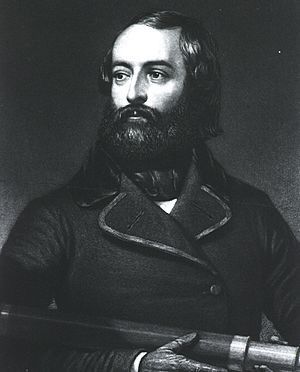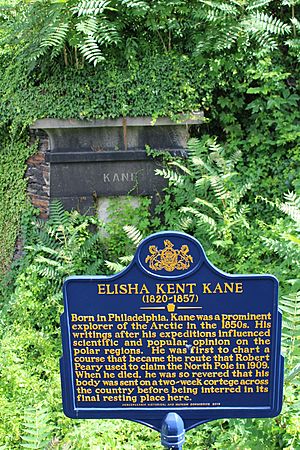Elisha Kent Kane facts for kids
Quick facts for kids
Elisha Kent Kane
|
|
|---|---|
 |
|
| Born | February 3, 1820 Philadelphia, Pennsylvania |
| Died | February 16, 1857 (aged 37) Havana, Cuba |
| Buried | |
| Allegiance | United States of America |
| Branch | United States Navy |
| Service years | 1843–1857 |
| Rank | Assistant surgeon |
| Expeditions | |
| Relations |
|
Elisha Kent Kane (born February 3, 1820 – died February 16, 1857) was a brave United States Navy doctor and an amazing Arctic explorer. He traveled the world and went on important missions for the U.S. Navy.
He was a key part of the First Grinnell expedition. This trip aimed to find out what happened to the famous explorer Sir John Franklin, who was lost in the Arctic. Kane helped discover a camp and graves from Franklin's lost team on Beechey Island.
Later, he led the Second Grinnell expedition even further north into the Arctic. Although they didn't find Franklin, Kane's explorations went further than anyone before him. His maps and discoveries helped future explorers find the way to the North Pole.
Kane also shared his adventures with many people. He gave talks to large crowds and wrote two books about his Arctic journeys. Several things were named after him, including two U.S. Navy ships, a crater on the Moon, and a waterway in the Arctic.
Contents
Early Life and Education
Elisha Kent Kane was born in Philadelphia on February 3, 1820. His father, John Kintzing Kane, was a U.S. judge. His family had strong ties to American history; his grandfather, Thomas Leiper, was a patriot during the American Revolutionary War. His brother, Thomas L. Kane, became a general during the American Civil War.
In 1837, Kane started studying civil engineering at the University of Virginia. He loved exploring and mapping geological formations in the Blue Ridge Mountains. However, he became very sick with rheumatic fever, which also affected his heart. This illness forced him to leave school and return home.
After recovering, he decided to study medicine instead. He thought it would be less physically demanding than engineering. He became a resident doctor at Blockley Almshouse and studied at the University of Pennsylvania. He graduated from the University of Pennsylvania Medical School in 1842.
Adventures and Expeditions
On September 14, 1843, Kane became an assistant surgeon in the Navy. This job allowed him to travel all over the world. He visited places like Bombay, Ceylon, and Rio de Janeiro.
He served on the USS Brandywine during a mission to China. While the U.S. negotiated a treaty, Kane explored the island of Luzon in the Philippines. He even climbed into the Taal Volcano to collect water samples. Later, he served in the Africa Squadron but became very ill and had to return home to recover.
In 1847, Kane was sent on a special mission during the Mexican–American War. He had to deliver an important message to General Winfield Scott in Mexico City. On his way, his group was attacked. Kane bravely treated a severely wounded Mexican general's son, saving his life. He also made sure that Mexican prisoners were treated fairly. When he returned to the U.S. in 1849, the city of Philadelphia honored him.
After his military service, Kane worked for the U.S. National Geodetic Survey. He helped map the southeast coast of the United States.
Searching for Sir John Franklin

Kane was chosen as the senior medical officer for the First Grinnell expedition in 1850–1851. This expedition searched for Sir John Franklin's lost team in the Arctic. Kane, along with other explorers, found a camp and three graves from Franklin's expedition on Beechey Island.
After this trip, Kane became a popular speaker. He gave many talks about his Arctic adventures to large audiences. He also started writing a book about the expedition. He convinced wealthy sponsors and scientific groups to fund a second expedition to continue the search for Franklin.
Leading the Second Grinnell Expedition
Kane led the Second Grinnell expedition on the ship USS Advance. They sailed from New York on May 31, 1853. The expedition picked up an Inuit hunter named Hans Hendrik and a sled driver, Johan Carl Christian Petersen, in Greenland. They spent the winter in Rensselaer Bay.
Despite suffering from scurvy and often being very ill, Kane pushed on. He mapped the coasts of Smith Sound and the Kane Basin. He explored further north than any other explorer had gone before. At Cape Constitution, he discovered the ice-free Kennedy Channel. This channel later became the path for other famous explorers, like Robert E. Peary, who were trying to reach the North Pole.
On May 20, 1855, Kane and his crew had to leave their ship, which was stuck in the ice. They began an 83-day march to Upernavik on the west coast of Greenland. They carried their sick companions and only lost one man during this incredibly difficult journey. A sailing ship eventually rescued Kane and his men.
Kane returned to New York on October 11, 1855. The next year, he published his two-volume book, Arctic Explorations. Even though his expedition didn't find Franklin, he was welcomed home as a hero. He used his fame to promote the idea of an "open polar sea," which he believed he had seen. He helped link Arctic exploration with American pride and scientific progress.
Death and Legacy

After visiting England to give his report to Lady Jane Franklin, Kane traveled to Havana, Cuba. His doctor advised him to go there to try and improve his health, but he was too ill. He died in Havana on February 16, 1857.
His body was brought back to the United States with great honor. His funeral procession was one of the largest in American history at that time. After lying in state at Independence Hall in Philadelphia, he was buried in his family's vault at Laurel Hill Cemetery.
Kane received many awards for his bravery and discoveries. He earned medals from the U.S. Congress, the Royal Geographical Society in England, and the Société de géographie in France. The Geographical Society of Philadelphia created the Elisha Kent Kane Medal in his honor. He was also elected a member of important scientific groups like the American Philosophical Society.
Many things were named to remember Kane's contributions. The historic Anoatok manor in Kane, Pennsylvania, was named after his Arctic expeditions. Two U.S. Navy ships, the USS Kane (DD-235) and the USNS Kane (T-AGS-27), were named for him. A lunar crater, Kane, also bears his name. In 1986, the U.S. Postal Service issued a postage stamp honoring him. The waterway between Greenland and Canada, once called Peabody Bay, was renamed Kane Basin in his honor. Cape Kane in Peary Land was also named after him.
Images for kids
See also
 In Spanish: Elisha Kent Kane para niños
In Spanish: Elisha Kent Kane para niños


